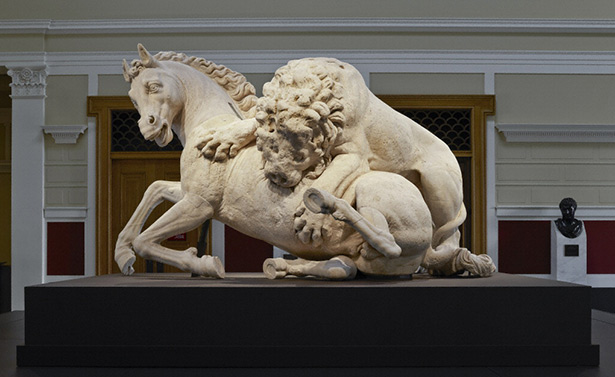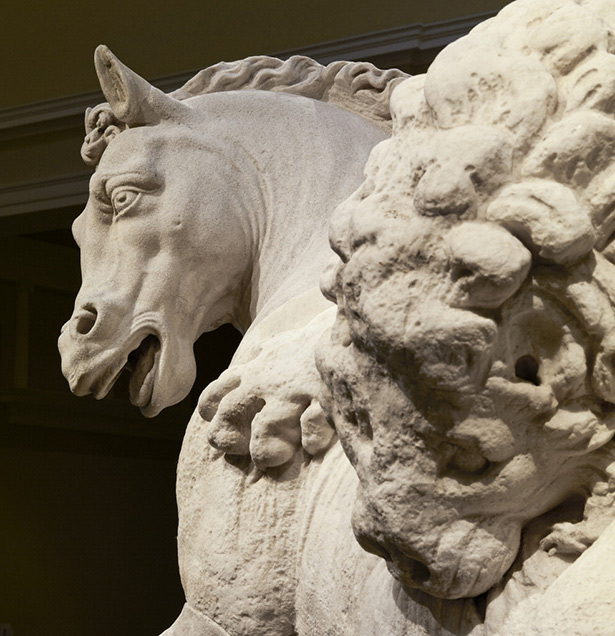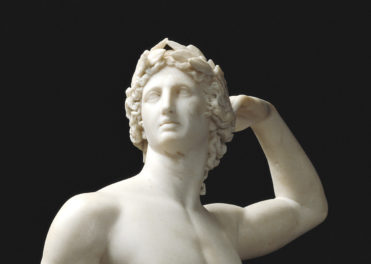
Lion Attacking a Horse, Greek, 325–300 B.C.; restored in Rome in 1594. Marble, 150 x 250 cm. Sovraintendenza ai Beni Culturali di Roma Capitale—Musei Capitolini
In August, the Greek sculpture Lion Attacking a Horse flew over the back wall of the Getty Villa and took up residence in our Atrium. We have now lived with the sculpture for over three months, and are already lamenting its coming departure in early February. This is definitely a sculpture that benefits from long acquaintance, close observation, and historical context. It grows on me every day, but I am still struck by how alien it is in some ways: visitors are interested, but many are not sure how they feel about the attack.
Today, watching visitors staring at the Lion with surprise, awe, and bemusement, I found myself making a list of reasons the Lion appeals to me, both as an artwork and as a window into understanding the classical past. Here are just seven ways of approaching this fearsome creature:
1. As Mighty Beast. Everyone is impressed by lions; we can trace a Western fascination with this powerful animal back to Homer and the Bronze Age, and humans have proved themselves against lions for millennia.
2. As Fragment of Lost Grandeur. This 3½-ton piece, only a fragment of a once-larger work, provides a rare glimpse of the size and grandeur of large sculptural groups in antiquity—most of which are now lost.
3. As Dialogue Across Time. A follower of Michelangelo restored the horse’s head and legs and the lion’s hindquarters, so this artwork merges two great periods of art history across 2,000 years. Thus it also encourages close observation of what is original and what was added. How do the restored parts affect our interpretation? I like to ask viewers to examine the lion’s legs. If you were a lion biting into a kicking horse, what would you do with your legs? (Hint: not what you see here.)
4. As Beauty and Pain. The lion with its shadowed eyes and mane, digging with claws and teeth into the poor stallion’s mobile flesh, embodies a Hellenistic approach to torment made beautiful. Late fourth-century B.C. (and later) artists maintained their appreciation for the perfect, calm forms of the fifth century. But they also experimented in new ways, and here we see how an artist beautifies the infliction of pain.
5. As Canvas for the Imagination. How much more impressive this sculpture would be if its color, long worn off by time, had survived! Visitors can imagine the two beasts painted with delicate tints, add the blood dripping down the horse’s flank, and then compare their mental picture with the Roman mosaic upstairs depicting a similar scene, with the colors crude, but intact.
6. As Stone. Realizing how hard it was to get the lion here and to install him in the Atrium helps us appreciate the difficulties of transporting objects weighing many tons across the ancient Mediterranean, before mechanization or air travel.
7. As Art. The sculpture is beautiful from all angles. Walking around what seems like the “back” (but would not have been on an intact sculpture), you can see how the lion’s body crushes downward, his weight and power beautifully contrasted with his almost delicate elbow.
As two of my curatorial colleagues prepare to teach an entire gallery course about this sculpture, I realize too clearly that there is no way to cover all these ways of seeing the Lion Attacking a Horse in one quick stop in the Atrium. When you visit the Villa, stop for a good, long look at the lion and the horse as you come and as you go—one look is definitely not enough.





Comments on this post are now closed.